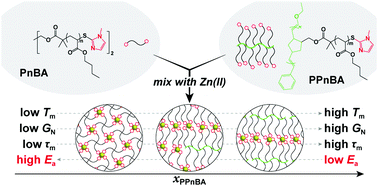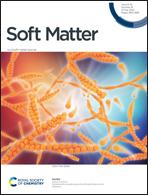Controlling the dynamics of elastomer networks with multivalent brush architectures†
Abstract
Herein, we report a design strategy for developing mechanically enhanced and dynamic polymer networks by incorporating a polymer with multivalent brush architecture. Different ratios of two types of imidazole functionalized polymers, specifically poly(n-butyl acrylate) (PnBA) and poly(poly(n-butyl acrylate)) (PPnBA) were blended with Zn(II) ions, thereby forming a series of elastomers with consistent composition but varying network topologies. As the weight fraction of PPnBA increased, the melting temperature, plateau modulus, and relaxation time of the melt increased because of the increase in the crosslinking density and coordination efficiency. Remarkably, however, the activation energy of the flow, Ea, decreased with increasing amounts of PPnBA despite the observed increases in mechanical properties. This unique behavior is attributed to the multivalent nature of the brush polymer, which allows the PPnBA to generate a higher crosslinking density than networks of linear PnBA, even though the brush polymers contain a lower weight fraction of the imidazole crosslinks. This method of lowering Ea, while improving the mechanical properties of the elastomers has great potential in the development of various soft materials such as self-healing or 3D-printable elastomeric structures.

- This article is part of the themed collection: Polymer Networks


 Please wait while we load your content...
Please wait while we load your content...